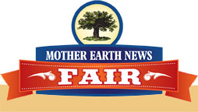 Visit us at
Visit us at
Mother Earth News Fair
Premier's booth #172
Lawrence, KS
October 12-13, 2013
FREE SHIPPING
AND SPECIAL PRICE
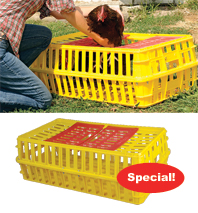
Free Shipping and Special Price!
Transport Crate
A safe, sturdy solution for moving all types of birds and other small animals.
Absolute free shipping on this item, no minimum order.
Free shipping not available to AK, HI, Mexico or Canada.
Special Note: Normal shipping on this item can be up to $40 (depending on ship-to location). Shipping for this item will appear in the checkout but will be adjusted in-house. If accompanied by other items, please see our Free Shipping details.
CATCH AND TRANSPORT
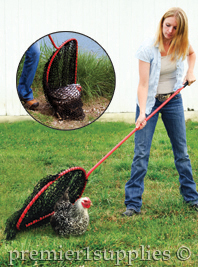
CatchNet™
Designed specifically with goat behavior in mind. Galvanized steel grid:
| • |
Gentle and safe. |
| • |
Preferred by users. |
| • |
Less stress on birds and humans. |
A unique device that enables folks to gently and safely catch chickens, ducks and gamebirds of nearly any size or age.
CONTAINING POULTRY
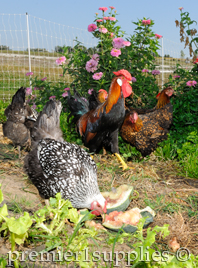
When the garden is done for the season, let your chickens in for cleanup duty. Keep them fenced in with electric netting for security.
What is poultry netting?
An electrifiable, prefabricated, portable fence. Arrives as a complete fence (except for an energizer and lightweight corner posts) with line posts built into each roll. We use it extensively on our farms for managing our poultry.
Fencing an area with multiple curves and corners?
Consider using PoultryNet™ Plus and PermaNet® Plus nets. The added posts provide increased support and help in reducing potential sagging.
PoultryNet™ 12/42/3
| • |
To contain and control the movement of chickens, ducks and other poultry. |
| • |
To prevent raccoons, coyotes, foxes, dogs, bears and other nonflying predators from killing poultry. |
| • |
To rotate poultry to fresh grass and to reduce disease risks. |
PoultryNet™ 12/48/3
| • |
To contain and control the movement of chickens, ducks and other poultry. |
| • |
To prevent raccoons, coyotes, foxes, dogs, bears and other nonflying predators from killing poultry. |
| • |
To rotate poultry to fresh grass and to reduce disease risks. |
PermaNet® 12/48/3
| • |
Boundary fence. |
| • |
Subdivision fence. |
| • |
Keep in/out all non-flying poultry. |
| • |
Keep out nonflying predators. |
Remember to electrify with our energizer kits.
PREMIER SOLAR ENERGIZERS
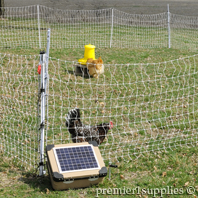
PoultyNet™ Plus 12/42/3 and a PRS 50 solar energizer are a popular combination for folks starting off with chickens. Both are easy to set up and use. For feeding chickens, we tend to prefer Saturn 15 feeder. It holds enough feed for most small-medium flocks and its feed saving grill reduces waste.
Which unit is right for you?
The size, in pulse energy output (range from .5 joule to 2 joules), depends almost entirely on the weed contact that will occur and the length of the fence.
Contact Premier or call 800-282-6631 to speak with one of our fence consultants to help you determine the best energizer for your needs.
You can also view our energizer comparison charts online or in Premier's fencing catalog for help in choosing an energizer.
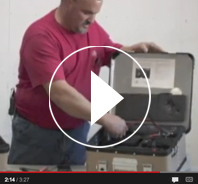
If it's the end of your fencing season, you'll find our video above on how to properly store your energizer and batteries for winter helpful, with instructions and tips the folks at Premier have learned by experience.
|
 |
 |
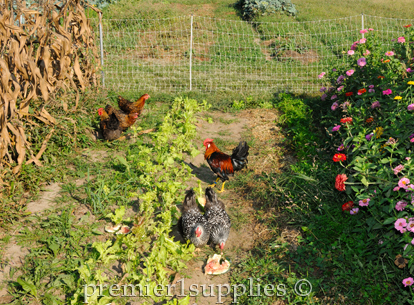
Our chickens welcome the opportunity to provide end-of-summer garden cleanup. Chickens are fenced in with PoultryNet™ Plus 12/48/3.
Putting chickens to work
in the garden
The weather is cooler and the days are shorter, which means the growing season is drawing to a close. So with the garden's produce either consumed or saved for later (via canning or other preservation methods), what should be done with the garden's remnants? It's an ideal time to let the chickens into the garden for cleanup duty.
During this growing season, we made an effort to keep the chickens out of Premier's garden. The energetic cluckers have a nasty habit of relocating carefully placed mulch and finding their way to the almost-ready tomatoes. Instead of allowing the garden to be continually henpecked, we fenced the birds out of the garden.
Now our garden is more or less finished for the season, so our birds can spend their days foraging through remnants of the various veggies we grew this summer and finding a few bugs at the same time.
See VIP article in this newsletter by Harvey Ussery of The Modern Homestead, where he shares his wisdom about using chickens to help composting in the garden.
Want some tips on how to "Save the surplus—from your garden"?
Read our latest Garden Newsletter.
VIP ARTICLE
The Lazy Gardener’s
Compost Heap
Note: This article was published in the Feb/Mar 2009 issue of Backyard Poultry Magazine (copyright by Harvey Ussery and reprinted with his permission).It was added to The Modern Homestead's site March 9, 2009.
(From a reader): Connected to our six-hen flock’s coop is an 8x4-ft run completely surrounded by 2x4-inch welded wire. (This includes the floor of the run, to exclude digging predators.) In this run we put everything that gets weeded from the garden, thinnings, some leaves, ears of corn that have been molested by raccoons, grass clippings, kitchen wastes—you get the idea. After each layer, I scatter oyster shell. Our hens stay very entertained digging through their sometimes three-foot-deep pile of goodies. The worms and bugs come naturally...About once every month we transfer our new fertile soil to the regular compost pile. Our garden loves it. I love not stirring or messing with the compost pile. Our yolks are school-bus orange-yellow and delicious.
~Nancy Muller, Dalton, Pennsylvania
Chicken-Powered Composting
Readers of articles on this site know that the key to my approach to poultry husbandry—indeed, to the whole homesteading enterprise—is integration of individual elements into broader patterns, in which one project serves several needs. I get excited by an integrated natural system like Karl Hammer’s (of Vermont Compost Company)—see “The Challenge of High Feed Costs”. But most of us backyard flocksters are not going to base our feeding programs on large deliveries of “food residuals” from restaurants and institutions. Perhaps we can take a hint from Carrie Shepard, quoted in that article, and from Nancy Muller, quoted above—and fashion a single backyard project that will, like VCC’s: recapture the fertility in our flock’s droppings for soil-building applications, while preventing their mobilization as runoff pollution; utilize the constant scratching of the flock to achieve work we would otherwise have to do ourselves, in the process engaging them in interesting activities in lieu of the boredom of confinement; enhance flock health; and boost the amount of “free feed” the chickens glean for themselves if given access to biologically diverse environments.
I have written about my use of a heavily mulched “feeding yard” onto which I release my greenhouse winter flock. In 2008, I expanded that concept into the growing season. Having seen what the birds can do to an eight-inch layer of hay over the course of a winter (reducing it to fine, fertile compost), I wondered if the birds might take on the job of composting during the rest of the year as well. Since early spring, therefore, I dumped all the organic “wastes” we would normally use to assemble a compost heap—corn and sunflower stalks and other crop plant residues; spoiled hay; “stable sweepings” from a neighbor’s horse barn; grass clippings; prunings from flower beds; autumn leaves; etc.—onto a ranging yard outside one of my chicken coops, surrounded by an electric net fence. Unlike when assembling a compost heap, I didn’t bother balancing nitrogenous and carbonaceous components, even moistening of the materials, or turning the heap—I just kept dumping on the new material as it became available. I put a flock of fourteen layers into that coop, with constant access to the debris heap.
For a couple of months the birds showed little interest in the pile. But as it became more biologically active—with pillbugs and crickets, earthworms and slugs, to say nothing of the burgeoning trillions of microbes—the birds started spending more time on it, scratching busily to find interesting things to eat. By the end of the season, the lower level of the heap was finished compost.
Benefits
Compost—Every gardener knows that a compost heap will process faster if the materials are shredded—the smaller the pieces, the more surface area for the “microherd” to inhabit and work. But a power shredder is expensive, high maintenance, wasteful of energy, and torture to the nervous system. The alternative to shredding is to turn the heap laboriously, thus urging on the micro-community. A lazy old gardener like me, seeking an easier way out, is thrilled that shredding the materials in a heap—all day, non-stop—is what my hard-working flock loves most to do.
As the chickens shred the material and boost microbial decomposition, the more finely shredded material sifts to the bottom, with the coarser material remaining on top as a protective cover. When we need to harvest compost for the garden, we can fork the coarse material aside and leave it for the chickens to continue working. Or we can simply scoop it all up: As we apply it, the finer portion will again sift to the bottom, with the coarser material remaining on top to help keep the lower level moist and more biologically active.
If the parent material of high-carbon components (such as leaves) is still recognizable, however finely shredded, it is probably better not to incorporate the compost into the soil—the resulting excess of carbonaceous litter, not yet broken down, might rob the soil of nitrogen needed by plant roots. But I practice mostly no-till gardening anyway, so am usually more inclined to lay the compost down on the untilled surface, and cover with a mulch.
Manure management—One of the least pleasant and most problematic aspects of poultry husbandry is dealing with the poops. Inside the coop, we exert a lot of effort to clear out and compost accumulated manure. Outside, the droppings can run off as a source of pollution of water systems. But releasing chickens onto a heap of organic “wastes” resolves all these vexatious issues: They deposit the droppings where they will be processed; work them into the heap, where they help fuel the population growth of earthworms and the microherd, and speed decomposition; and ensure that the fertility is bound up in the decomposition products of the heap rather than running for the sea—all with absolutely no additional labor input from us.
Free natural feed—As the heap becomes more alive, there are more sources of high quality, nutrient dense natural feeds available to the flock—earthworms, slugs, snails, pill bugs, etc. As the experiment with my chicken-power compost heap progressed, I found that the hens spent more of their time working the debris field, often ignoring feed still in the feeder.
Health enhancement—Metabolites of the microbes driving decomposition in the heap include Vitamins K and B12. Fungal filaments growing in the heap—avidly eaten by the chickens—may provide potent immune-enhancing and antibacterial compounds. And don’t forget the “mental health” factor: Unquestionably, the flock was more happy and content, because of the sheer entertainment value of their foraging field, in contrast to the stress and boredom of close confinement.
Applications
The improved chicken run—Readers of my articles know that pasturing my flock in the growing season is fundamental to my husbandry. But many flock owners do not have the option of pasturing, and are forced by circumstances to confine their flock to a static chicken run. The most valuable application of the chicken-powered compost heap for them is the opportunity for creating a much more wholesome and pleasant, non-polluting, fertility-capturing alternative—and one which saves on the feed bill as well. I have never seen a static run which would not have been immeasurably improved if all the homestead’s organic “wastes” were used to make a heavy mixed mulch over the yard, applying in effect the same sort of deep litter over an earth floor that is the key to best manure management inside the henhouse.
My only caution: The make-up of the debris field should be diverse enough to prevent matting down and/or becoming waterlogged. I once spread fresh grass clippings several inches deep over the entire chicken yard. The result was a nightmare: a slick, putrid, anaerobic mess underfoot, impossible for the birds to work, lacking the oxygen for active decomposition. If you live in an area with a great deal of rain, you might even want to put an open-sided roof over the run, to help keep the compost litter drier and looser. If there are sufficient coarse components, however, the heap is not likely to mat tightly and resist working by the busy fowl.
Opening up new garden ground—Again, I am delighted that my birds are willing to do work that this lazy old gardener would rather shun. Turning over established sod with hand tools strains the back; and it’s been years since I kept a shrieking, nerve-numbing power tiller in the stable. If I lay down a heavy debris field, however, it smothers the sod, the chickens till it in, and in the process turn the organic duff into a fertile mulch/compost. In many soils, this preparation can be followed by simply raking out the litter into an even cover, and planting. This new ground still has a long way to go to become best garden soil, but even in the first season is well on the way.
Fighting the jungle—Ditto for heavily weed-grown areas: In lieu of “fighting the jungle” ourselves, why not cover the area with our compost materials and send in the chickens until the the weeds are destroyed, their roots are opening up channels in the soil as they decompose, and their seeds have been eaten by the birds?
This article is Copyright by Harvey Ussery and reprinted with permission. Harvey Ussery is the author of The Small Scale Poultry Flock (Chelsea Green, 2011), on sale in Premier's book section. Visit Harvey's website at www.themodernhomestead.us.
Read More »
|
|